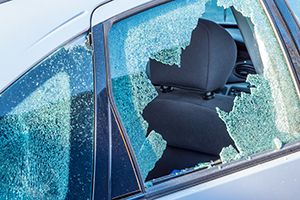C.G.S. § 53a-117 — Criminal Mischief in the Third Degree
 A person commits Criminal Mischief in the Third Degree when, having no reasonable ground to believe they have a right to do so, they do any of the following:
A person commits Criminal Mischief in the Third Degree when, having no reasonable ground to believe they have a right to do so, they do any of the following:
- Intentionally or recklessly damage tangible property of another, or tamper with such property in a way that puts it in danger of damage;
- Damage another’s tangible property by negligence involving a potentially harmful or destructive force or substance (for example, fire, explosives, flood, building collapse, poison gas, radioactive material);
- Intentionally or recklessly damage or tamper with state or municipal property located on public land, placing it in danger of damage; or
- Damage such public property by negligence involving a harmful or destructive force or substance.
- The accused damaged tangible property of another, or tampered with it so it was placed in danger of damage;
- The conduct was done intentionally, recklessly, or (for certain clauses) by negligence involving a harmful/destructive force or substance; and
- The accused had no reasonable ground to believe they had a right to do so (no permission/authorization).
- Class B misdemeanor
- Up to 6 months in jail
- Fine up to $1,000
- Probation possible (often with restitution, no-contact orders, counseling)
- In domestic contexts, the case may proceed on the family-violence docket with protective orders
- Property damage during disputes between neighbors, roommates, or ex-partners.
- Tampering with someone else’s vehicle, tools, or equipment in a way that risks damage.
- Damage to public property on parks or school grounds (benches, signs, bathrooms).
- Negligent use of dangerous substances (solvents, fireworks, open flame) that damages another’s property.
- Vehicle tampering in a driveway: During an argument, someone lets the air out of a neighbor’s tires and loosens a valve stem. Even if the tire doesn’t pop immediately, the tampering placed the property in danger of damage, satisfying the statute’s risk component.
- Bleach poured on clothing in a shared laundry room: To “teach a lesson,” a tenant pours bleach into another tenant’s laundry, ruining garments. This is intentional damage to another’s property with no right to do so.
- State park sign vandalism: Late at night, a group pries a municipal trail marker off its post on public land and sprays paint on nearby fixtures. That’s state/municipal property on public land, and the intentional damage/tampering fits the public-property prongs.
- Accident without recklessness (not guilty example): A homeowner’s water heater bursts unexpectedly and floods the unit below. Maintenance records show the heater was up to code with no prior warning signs. Without intent, recklessness, or negligence involving a harmful force (beyond normal, unforeseeable malfunction), the elements of § 53a-117 are not met.
- § 53a-115 — Criminal Mischief in the First Degree (Class D felony; higher-end damage/critical facilities)
- § 53a-116 — Criminal Mischief in the Second Degree (Class A misdemeanor; more serious or higher-value damage)
- § 53a-117a — Criminal Mischief in the Fourth Degree (Class C misdemeanor; hydrants/alarms/public-safety gear)
- § 53a-117g — Criminal Damage of a Landlord’s Property in the Third Degree (landlord-tenant specific)
- § 53a-107/108/109 — Criminal Trespass (often added in property cases)
- § 53a-181 — Breach of Peace 2nd / § 53a-182 — Disorderly Conduct (companion charges)
Element challenges
- Right/consent: Show permission, ownership, or a reasonable belief of the right to act (work orders, texts, lease terms).
- Mens rea: Reframe as accident or ordinary negligence not involving a harmful/destructive force; or show no recklessness and no intent to damage.
- “Placed in danger” proof: Demand specifics on how the tampering actually created a genuine risk of damage (photos, expert input).
- Identification & proof: Use video, digital footprints, and witness credibility to challenge who did what.
Negotiation pathways
- Restitution-forward resolutions (repair/replace property) to minimize penalties.
- Reductions to § 53a-117a (Fourth Degree) or to non-mischief misdemeanors (Disorderly Conduct, Breach of Peace) when facts support lesser risk/damage.
- In domestic settings, tailor protective orders to avoid unnecessary hardship while ensuring compliance.
Diversionary options
- Accelerated Rehabilitation (AR): Commonly available for eligible first-time offenders; successful completion typically leads to dismissal/erasure.
- Family Violence Education Program (FVEP): If on the family-violence docket and facts fit, FVEP may resolve the case without a conviction upon completion.
A § 53a-117 arrest puts your record and reputation at risk. We move fast to secure video, document ownership/consent, quantify damage, press restitution, and pursue AR, FVEP, or charge reductions where the facts support it.
Call (203) 357-5555 or fill out my contact form for a free, confidential consultation. We defend clients across Connecticut and fight to protect your record, your rights, and your future.
 Allan F. Friedman Criminal Lawyer Home
Allan F. Friedman Criminal Lawyer Home















